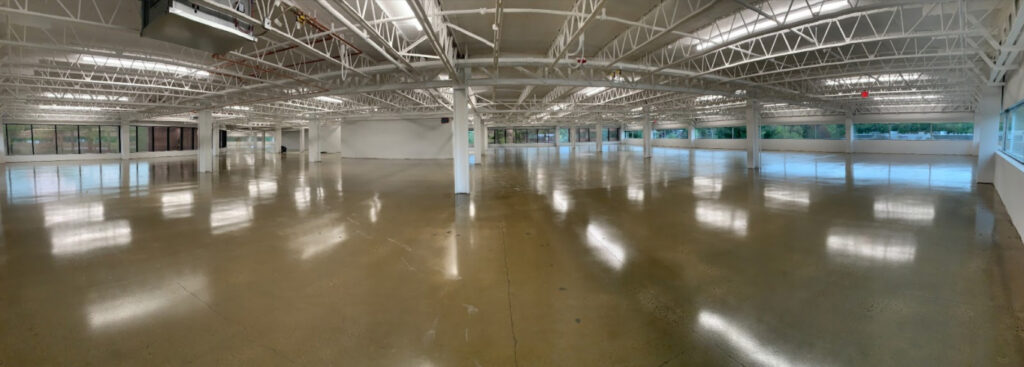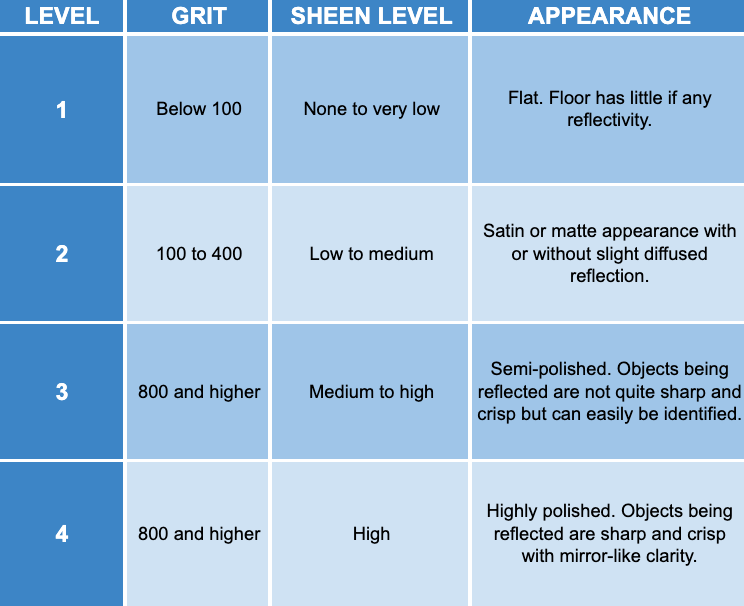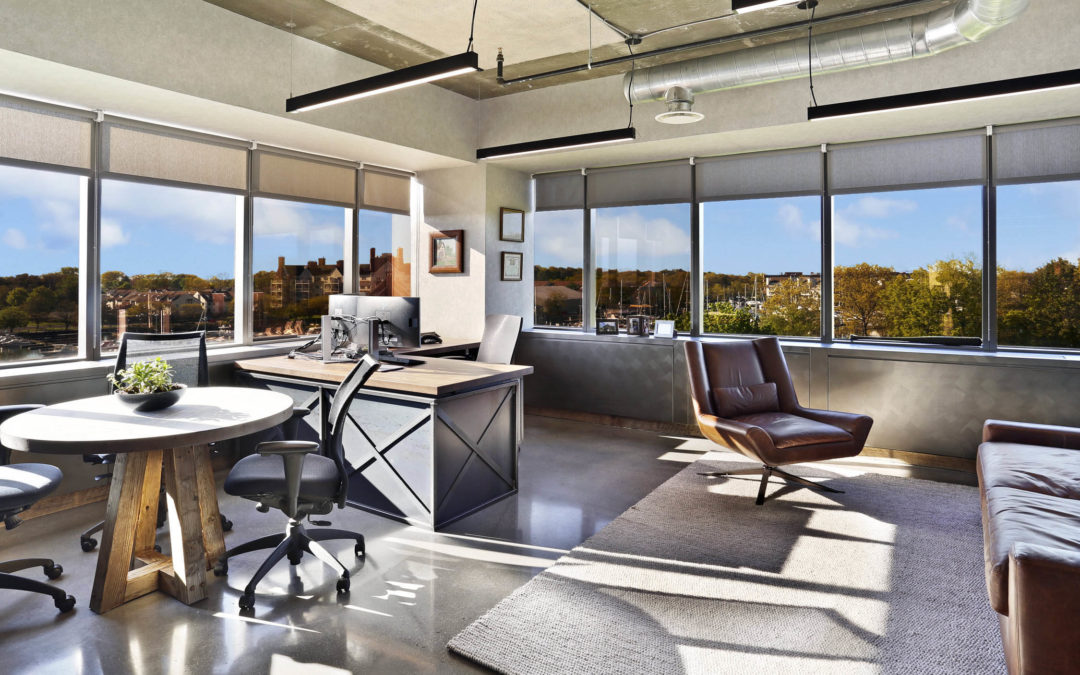When looking at a shiny concrete surface people oftentimes mistake a sealed concrete for a polished concrete finish. We see this big mistake with customers, general contractors, and architects who see a floor with a high gloss sealer on a ground concrete slab and assume this is polished concrete – and it is not. It is one of the most misused industry terms. The differences are quite significant in process, duration, cost, and durability. For polished concrete, the concrete is polished using finer grits of diamond abrasives until the floor reaches the desired level of shine (level 1-4). However, with sealed concrete, the finish is achieved from a high-performance sealer.
Everlast Industrial Flooring offers both polished concrete and sealed concrete services. Don’t make the mistake like many and ask for a polished concrete finish not only to receive a grind and seal. Now you will know the difference!
Sealed Concrete
Also known as Grind and seal – The concrete is cleaned and allowed to dry. A thin layer of acrylic, epoxy, or
urethane sealers is spread on the concrete, applied in a similar fashion as paint. Once dry, the surface is shiny because there is a thin layer of acrylic, epoxy, or urethane covering that has filled the voids of the concrete.
Some sealers are specially formulated to prevent moisture intrusion under finished floors, and often times sealed concrete is used for cheap, low traffic areas (such as stairwells, IT rooms, file storage, etc.) When choosing a sealed concrete finish its important to know how many steps of grinding are needed to give your floor a smooth flawless appearance underneath the clear sealer so no heavy scratches are shown. The grinding process is typically a one or two-step grind.
The downfall of a sealed concrete is they wear out quickly and are susceptible to damage due to heavy traffic/ impact on top of the slab. Resealing is required every few years as sealed concrete surfaces due wear out over time back to raw concrete, especially in high traffic areas. A sealed concrete finish never has the same clarity or “pop” as a piece of correctly polished concrete.

Pros
- Much less labor-intensive
- More cost-effective – often half the price of polished concrete
- With the right product and surface preparation– will not harbor bacteria
- Epoxy and Urethane sealers are UV and abrasion-resistant.
- Helps protect against grease, oil spills, and stains.
Cons
- Ongoing costs which requires resealing and maintenance.
- Works best in low traffic areas
- Not always moisture tolerant, moisture testing and mitigation may be required.
- Low grade sealers can scratch easy and damage due to heavy traffic /impact on slab.
Polished Concrete
Polished Concrete floors are built by grinding the surface of the concrete with ever-finer grits of diamond tooling in multiple steps until the surface is completely smooth and scratch-free. Densifiers are applied to harden and strengthen the concrete surface and when the finished polishing level is achieved (Levels 1-4) seal guard products are used, which is then burnished into the concrete. During these grinding passes, control joints, cracks, spalls, and other imperfections can be filled and repaired to make a seamless floor. During the grinding, various aggregate and concrete features that have been buried since placement become visible creating a beautiful, one of a kind floor.
Burnishing is the final step in the polishing process. Its power lies in bringing out the glossy shine of polished concrete. It is not a sealant.
Burnishing concrete is a system that utilizes high-speed burnishers that are designed to heat, melt and buff the seal guard treatment into a polished concrete surface. Sealants such as the Retroplate system protect concrete floors from staining and prevent dusting and when burnished it creates a high gloss and shine. Depending on grit level; a flat, matte, satin, semi-polished, or highly polished glassy like finish can be achieved. Your floor shine levels can range from very low to very high depending on how many steps are taken to cut the concrete.
By densifying and sealing the surface, polished concrete transforms a porous concrete floor into a tightened floor that is dense enough to repel water, oil, and other contaminants, preventing them from penetrating the surface. Polished concrete, though shiny on the surface, does not create a slippery floor. In fact, the benefits of mechanically grinding and flattening the floor ultimately increase the coefficient of friction when compared to ordinary concrete. Polished concrete often exceeds OSHA standards for floors.
Polished Concrete is, therefore, a great choice for high traffic, high visibility areas that should be functional, beautiful, and long-lasting. Some great examples are open office areas, lobbies, cafeterias, conference rooms, hallways, bathrooms, chemical storage areas, warehouses, manufacturing facilities, schools, retail establishments, restaurant dining areas, grocery stores, medical facilities, big box stores, hotels, auto showrooms, municipal buildings, apparatus bays and whatever else you can dream up!

Pros
- One time application and minimal maintenance.
- Long life Cycle
- Safer surface- increased slip resistance exceeds OSHA standards
- High Durability and Abrasion resistant
- Reflective surface maximizes available light- saving energy
- Resistant to moisture transmission issues
- Lower initial costs compared to traditional floor coverings such as vct, tile and wood.
- Sanitary and does not harbor bacteria.
- No VOC
- Chemical and thermal shock resistant.
Cons
- Hardness- The strength and durability of this material can make the surface very hard, so it won’t cushion or “give” under feet.
- Cold- does not retain heat very well.
- Loud- floors can be loud like ceramic tile, natural stone flooring and hardwood
- Moisture can be a problem if the floor is not finished properly by a highly experienced polished concrete installer.
- More expensive then a grind and seal application but much more durable.
POLISHED CONCRETE GLOSS LEVEL TABLE

It is important that you know the differences and do your research prior to your slab being poured, and if opting for a mechanical polish, ensure your builder and concrete contractor know the differences also and can plan and pour to cater to your desired finish.
And when getting quotes, for a Polished Concrete and grind and seal it is very important to compare apple with apples as there are many variables to compare – machinery used, number of passes, the experience of contractor, type, and quality of materials used. Concrete polishing is more labor-intensive and costs more than a grind and seal. If you are interested in polished concrete floors but would like a more affordable option, we can recommend a high-end sealed concrete finish that can be customized for your environment.
Share this article using the icons below!

